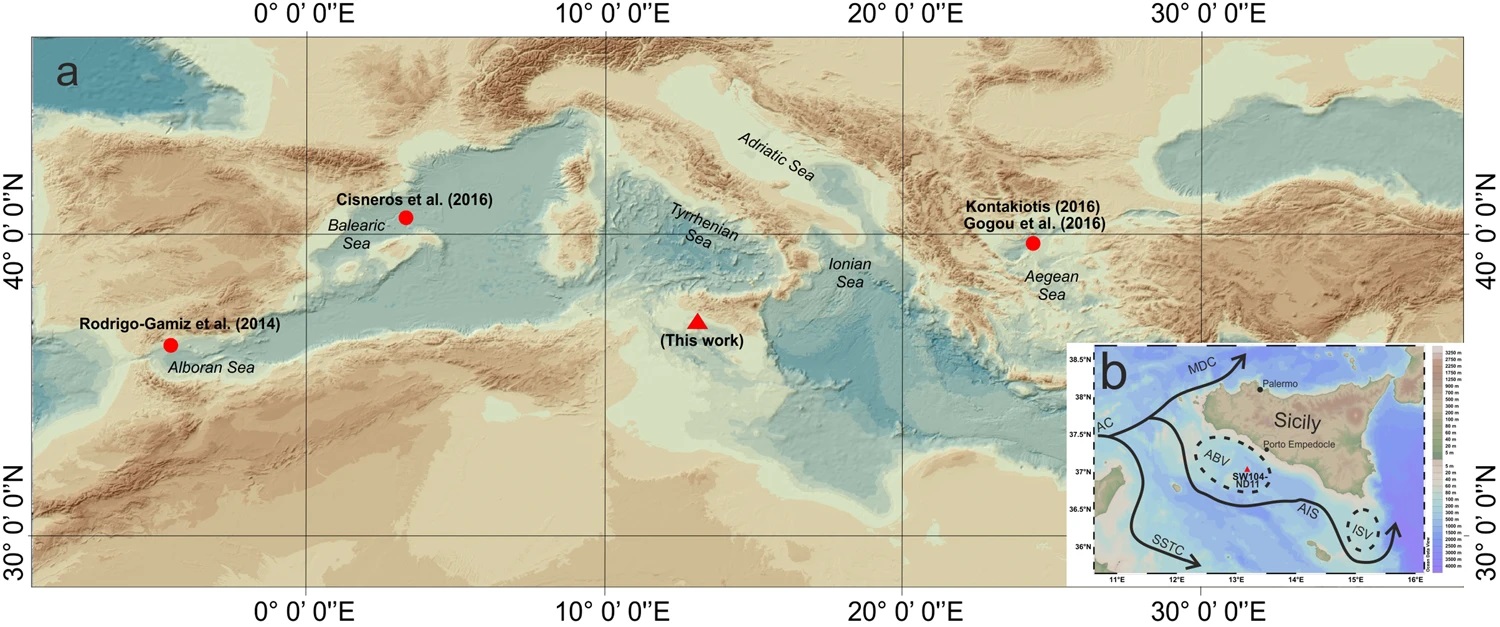Mediterranean Sea was 2 degrees hotter during Roman Empire

(a) Bathymetric map of the central-western Mediterranean Sea. Red triangle: location of SW104 ND11 core; red circles: marine records used for the comparison; (b) Bathymetric map of the Sicily Channel showing surface oceanographic circulation and core location. Black lines follow the path of surface water circulation. Major currents are illustrated [Credit: Margaritelli et al. 2020]
Previous studies had related the fall of the Roman Empire to some
natural factors (climate change, volcanic eruptions, etc.). With a
large-scale regional view, the study provides high resolution and
precision data on how the temperatures evolved over the last 2,000 years
in the Mediterranean area. “For the first time, we can state the roman
period was the warmest period of time of the last 2,000 years, and these
conditions lasted for 500 years”, notes Isabel Cacho, professor at the
Department of Earth and Ocean Dynamics of the UB.
The
Mediterranean Sea is a semi-closed sea –extremely vulnerable to modern
and past climate changes – with a strategic location. Home to many
civilizations over the years –with a tradition for historical and
archaeological studies – Mare Nostrum is a model to study the periods of
climate variation and climate potential influence in civilizations.
In particular, the Roman Empire period is hard to study, “since it coincided with important cultural changes that took place around the Mediterranean. The study of the climate of the past is now the only tool to analyze the dynamics of the climate System of the Earth in different conditions from the current ones, and it is essential to test the validity of the mid and long term prediction models”, note the experts Giulia Margaritelli (also member of the CNR-IRPI) and Fabrizio Lirer (CNR-ISMAR).
The study identifies for the first time a warming phase which is different during the Roman period in the Mediterranean area and is focused on the reconstruction of the sea surface temperature (SST) over the last 5,000 years. These new records were correlated to data from other areas of the Mediterranean (Alboran Sea, Menorca basin and Aegean Sea) to show a regional signal of the basin to identify the Roman period (1-500 AD) as the warmest period of the last 2,000 years, 2ºC warmer than the average values at the end of the century. The experts also comment on the impact of the rainfall regime during this period –marked by a great regional variation of the most wet and arid phases- in the evolution of the Roman Empire.

Comparison of the Sea Surface Temperature (SST) records from Sicily Channel (thick dark blue line), Alboran Sea (thick light blue line), Minorca Basin (thick red line) and Aegean Sea (thick dark and light green lines) expressed as SST anomalies in relation with the reference period from 750 BCE to 1250 CE (the only period shared by all the records) in order to better compare the amplitude of the changes across the Mediterranean Credit: Margaritelli et al. 2020]
According to the authors, this phase coincides with the development of the expansion of the Roman Empire, which suggests a potential relation between favouring climate conditions and the change into the great empire founded by Octavius Augustus in 27 BC. According to the hypotheses of the authors, a climate transition from wet to arid conditions could have market its following decline.
This article appeared on the Watts Up With That? website at https://wattsupwiththat.com/2020/07/27/mediterranean-sea-was-2-degrees-hotter-during-roman-empire/
]]>